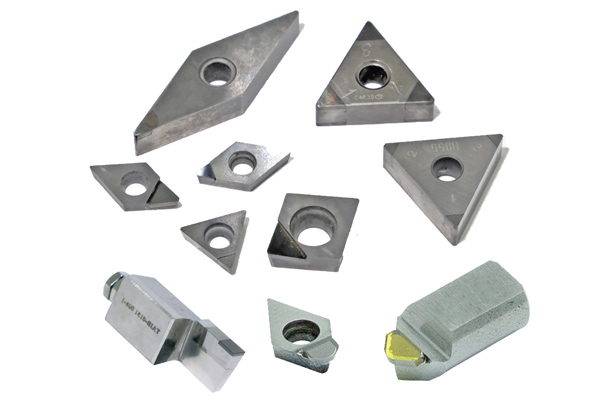1. The difference of coating
Amorphous diamond (also known as diamond-like carbon - Annotation) coating is a carbon film deposited using the PVD process. It has both a part of the SP3 bond of diamond and a part of the SP2 bond of carbon. Its film hardness is very high, but lower than that of diamond film. Its thickness is also thinner than the diamond film we usually deposit.
When machining graphite, the life of amorphous diamond-coated tools is 2-3 times longer than that of uncoated carbide tools. In contrast, CVD diamond is a pure diamond coating deposited by CVD process, and the tool life when machining graphite is 12-20 times that of cemented carbide tools, which can reduce the number of tool changes and improve the reliability and accuracy of machining. consistency.
2. Processing hardened steel
Diamond is made up of carbon atoms. When some materials are heated, carbon atoms are drawn from the diamond and carbides are formed in the workpiece. Iron is one such material. When diamond tools are used to machine iron group materials, the heat generated by friction can cause the carbon atoms in the diamond to diffuse into the iron, causing the diamond coating to fail prematurely due to chemical wear.
3. Tool limitations
Regrinding and/or recoating of diamond-coated tools is difficult to ensure that the quality of the tool surface is pure diamond, so it takes a long time to regrind the tool with a diamond grinding wheel.
In addition, the tool used for diamond growth. The preparation process changes the chemical properties of the tool surface, and because the coating requires very precise control of this chemical property, it is difficult to guarantee the effect of recoating the tool.
4. Tool life
Like any other tool, the life of diamond-coated tools varies, depending on the material being cut, the feed rate and cutting speed selected, and the geometry of the workpiece. In general, diamond-coated tools for machining graphite will last 10-20 times longer than uncoated carbide tools, and in some cases even longer.
In this way, almost any machining task can be performed with one tool, without the need for tool changes due to tool wear, machining interruptions and recalibrations are avoided, and unattended machining is possible. In the machining of composite materials, it is also entirely possible to obtain longer tool life.
5. Types and uses of diamond tools
A. Single crystal diamond spiral milling cutter:
Features: The single-edged diamond spiral milling cutter, whose diameter can be as small as 2.0mm, is mainly used for micro-hole processing, and can perform continuous and vibration-free cutting processing.
Usages: Generally used in the processing of mobile phone buttons and handsets.
B. Diamond Polishing Knife
Features: The handle requirements of the diamond polishing knife: BT40/30, the recommended number of revolutions: 3000 (min-1), the cutting speed: 120-200mmr/min, the feed rate: 0.03-0.05mm. It is necessary to adjust the number of revolutions and tool passes reasonably according to the depth of cut, rigidity of the machine tool and other usage conditions.
Usages: Mainly used for fine polishing of acrylic panels, liquid crystal panels, light guide plate modules, mirrors, central air-conditioning frames and aluminum alloy panels, as well as vertical machine tools.
C. Diamond highlighter
Features: According to different welding methods, chamfering cutters can be divided into two types: high-gloss chamfering tools and high-gloss milling tools.
Usages: High-gloss chamfering knives can be used for high-gloss chamfering knives such as digital camera casings, DVD/VCD/audio knobs, furniture decorations, and digital lenses. It can achieve no burrs, no scratches, good drainage, and mirror highlights.
D. Diamond turning tool
Features: Diamond turning tools include sharp turning tools for turning motor rotors, CD pattern turning tools for aluminum alloy shells, flat-bottom turning tools, cylindrical turning tools, and high-gloss chamfering turning tools.
Usages: used in the cutting of copper, aluminum alloy, stainless steel and other materials.
